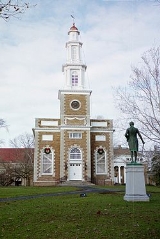
Hamilton College Chapel
Encyclopedia


Philip Hooker
Philip Hooker was at one time the leading architect of New York State outside of New York City. He designed Hyde Hall, the facade of the Hamilton College Chapel, The Albany Academy, Albany City Hall, Hart-Cluett Mansion and the original New York State Capitol building. He is believed to have...
, notable for his many designs of public buildings in Albany, NY, as well as for designing Hyde Hall
Hyde Hall
Hyde Hall was the unusually large home—a neoclassical country mansion—of George Clarke, 1768–1835, heir of George Clarke ....
in Springfield Center, NY. The conservative Federal style of the chapel is characteristic of Hooker’s work. The distinctive three story main body and interior design are credited to John H. Lothrop, a Hamilton College trustee. The design includes three bays on the eastern façade and eight bays of double hung windows along the north and south faces of the building. The mellow orange of the stone body of the chapel is Oriskany stone, while the corner quoins are of Trenton limestone. The Oriskany stone was quarried and laid by Reuben Wilcox of Whitestown, NY. The interior carpentry was done by Deacon Isaac Williams, of Clinton, NY. The tower of the eastern façade of the building is topped by a white, octagonal cupola. The quill weathervane atop the cupola is representative of Hamilton College’s commitment to teaching students to write effectively.
The chapel was originally designed as classrooms and offices, as well as the chapel proper. Spaces in the building have been used for many purposes. Until 1872 the college library was housed in increasing portions of the top floor the chapel. From 1830-1855 the chemistry lab was lodged in the cellar. Commencement exercises were held in the chapel from 1898-1946. Currently, as well as for religious services, the chapel is used for public lectures, concerts and assemblies.
Many changes have been made to the building. In 1877 the three faced clock still in evidence today was donated by John Wanamaker
John Wanamaker
John Wanamaker was a United States merchant, religious leader, civic and political figure, considered by some to be the father of modern advertising and a "pioneer in marketing." Wanamaker was born in Philadelphia, Pennsylvania.-Biography:He was born on July 11, 1838.He opened his first store in...
, of Philadelphia. In 1893, the steeple was restored. The current bell was installed in 1902, and electrified in 1950. Electricity was installed in the building in 1907, and fire fighting equipment in 1916. In 1949, the interior was remodeled. More recently, in 1999 the third floor office and meeting space was renovated.
External links
- "A Neat Plain Modern Stile: Philip Hooker and His Contemporaries: 1796-1836", University of Massachusetts Press ISBN 0-87023-768-3 (a history and art exhibition). (Excerpt at Google Books version accessed January, 2008)

